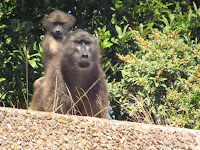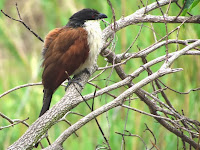At this time of the year nature is at its most extravagant in the southern hemisphere - as this magnificent floral arrangement of 1 of many
pincushion protea displays . . .
. . . or these
pelargornium with their array of colour . . .
. . . as well as these
erica highlighted by the afternoon sun.
Adding a "neutral" colour are these
sewe-jaartjies (immortelles = daisy family if looking like dried flowers) presently blooming amongst many other
fynbos (the Cape Floral Kingdom).
As is often the case with regard to the ENORMOUS range of indigenous plants found in South Africa, I haven't been able so far to identify this interesting "bouquet", which looks like another species of
immortelle I discovered growing amongst the sewe-jaartjies (see above) in the Cape of Good Hope Nature Reserve.
I'm not even sure if this is an indigenous flower (found it growing in the Storms River bridge area), but I believe it "deserves" to be included as another example of how nature "creates" its own bouquets.
Last but not least - another species of the
pincushion protea family presently on natural display in the Cape Floral region.






















































